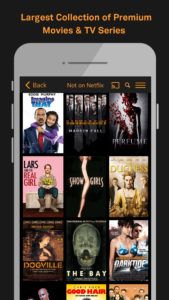 Tubi TV knows that not everyone wants to pay for premium content.
Tubi TV knows that not everyone wants to pay for premium content.
“We see a strong desire among viewers who want free content, whether they’re viewers in search of value or subscription viewers who can’t find the content they want on their SVOD [subscription video on demand] service,” said Thomas Ahn Hicks, co-founder and head of strategy for Tubi TV.
Tubi has 9.7 million monthly mobile users on iOS and Android devices alone apart from its smart TV streams, according to research from Parks Associates noting mobile tracking data. It competes with other AVOD [ad-supported video on demand] services such as Sony Crackle.
Before Tubi was a consumer destination for free on-demand videos and movies it was the OTT ad platform AdRise and helped premium content owners like Paramount, MGM and Lionsgate distribute and monetize connected TV content.
Some of those partners licensed movie titles to Tubi and, in 2015, Lionsgate and MGM became investors.
Since then, Tubi’s been heads-down building its streaming content library – and aiming for more ad revenue through new sales arrangements like with Facebook’s Audience Network.
Ahn Hicks spoke with AdExchanger.
AdExchanger: How is Tubi TV approaching the video market?
THOMAS AHN HICKS: You have traditional cable, pay-TV providers launching streaming, TV everywhere services, such as HBO Go or Showtime Anytime. The other area is internet platforms like YouTube with creators and mostly personality-driven, user-generated content.
And then you have SVOD players like Netflix, Amazon and Hulu and a litany of others who are going after the remaining 10% or so of the market that isn’t Netflix, Amazon and Hulu.
We don’t see ourselves as a complementary service, nor necessarily as a dominant service to any of those, but we do think the market is going to strengthen for a premium, free viewing experience.
AdExchanger Daily
Get our editors’ roundup delivered to your inbox every weekday.
Daily Roundup
How is your content strategy different than other subscription or ad-supported video services?
All of our content is library content, meaning content that’s not actively licensed to the TV broadcasters and cable networks. We can bring video from these premium content partners in a way that’s free to viewers. That increases the top of the funnel of how many people can come in versus a paid service, which requires you to put down a credit card.
Because we build our own apps and we integrate our ad technology into those apps, we can seamlessly deploy advertising as well as content across all these heterogeneous devices, whether mobile, OTT or web.
 What is your ad technology backbone?
What is your ad technology backbone?
Our company started as an ad stack for OTT. You had all these ad servers built for web, flash and eventually they were ported over to mobile. They weren’t built for OTT devices, where pixels and cookies [were less prevalent]. A lot of devices like Xbox 360 were never really meant to have a video streaming app with a video ad monetizing the content. And so we did a lot of hard work to figure that out and put some of those capabilities into one, unified ad server
How do you approach audience targeting?
We’re able to do behavioral and demographic mapping of our viewers, which lets us provide better recommendations, as well as figure out what content we should be doubling down on or what we should be scaling back on. On the advertising side, we were one of the first companies to do a lot of interactive ads across OTT platforms, though we scaled that back and work now with [interactive video ad server] Brightline primarily.
And where do you see your work with digital players like Facebook going?
You’re going to see video players like Facebook wanting to get the TV dollars. They can monetize through their short-form content, but long-form, premium content will always have a place and it’s much easier to monetize because you’re talking about mid-rolls. You can put multiple ads in that mid-roll.
What’s been the biggest problem for publishers who want to monetize their OTT apps?
A major hurdle is this heterogeneous environment. Its not like web where there are standards that allow you to build for a lot of different browsers at once. On mobile, your software development requirements are primarily Android and iOS. In OTT, you’re talking about game consoles, smart TVs, streaming devices and each will be a little bit different in terms of how you build out apps.
Then if you want to build out ad technology that’s integrated into DoubleClick for Publishers or FreeWheel or any other major third-party ad server, it gets fairly complicated and you need a large team. Most publishers don’t have the resources to fund that project, or they may not have the internal technical competency. After that, it’s a matter of whether you have enough content to keep viewers coming back.
What did you think of Google’s decision to bring search data into YouTube targeting? And their decision to pull back on third-party pixels?
I assume there are some competitive pressures, particularly from Facebook. And I have no real knowledge about this, but there may be data protection issues, which may be precipitating these changes. But I would imagine it’s mostly business-driven based on what the competitive landscape looks like.
As you know, marketers and advertisers love Facebook for the exposure they can get and knowing who their viewership is. This is something Google has been looking at for a while, I would assume.
Interview edited and condensed.













